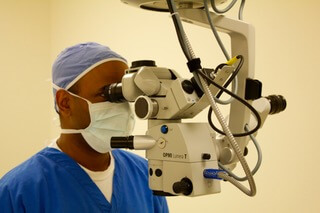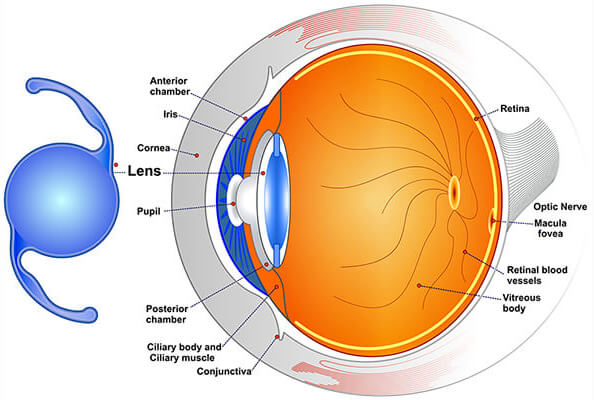Cataract Surgery
About Cataract Surgery

The lens of your eye functions similar to the lens inside a camera or microscope. Its purpose is to focus light that enters the eye so you can see the world around you. When cataracts form, the lens of your eye becomes clouded with proteins, which make it difficult to see clearly. If cataracts are left untreated, you can suffer from severe vision loss.
Fortunately, cataract surgery is safe, effective, and quite common. Thanks to advanced surgical procedures and lens implant technology, cataract surgery is not only one of the most frequently performed surgical procedures in the United States, it’s also one of the safest and most successful surgeries available.
When Should I Have Cataract Surgery?
When your cataracts cause poor vision that affects your quality of life or interferes with your ability to do the things you love, it’s time to consider cataract surgery. Advancements in surgical technique and medical technology have made cataract surgery one of the most effective procedures in medicine to date.
If you’re tired of experiencing these signs of cataracts, schedule an appointment with us to find out how cataract surgery can change your life:

- Clouded, blurry or double vision
- Difficulty seeing at night
- Trouble seeing to read or write
- Sensitivity to bright light and glare
- Halo-effect around lights
- Constant changes to your prescription for glasses or contacts
- Yellow or brown tinted vision
How Long Does Cataract Surgery Take?
While the surgery may only take 20 minutes, you should expect to be at our facility for about 90 minutes on the day of your procedure. Our facility, The Eye Surgery Center, is located in South Burlington and is the only one in Vermont that specializes only in eye surgery.
Even though the procedure and recovery times are short, we recommend taking the full day off from your regular routine in order to give your mind and body a chance to rest. Surgery can be physically and emotionally draining for many patients, so it’s important to take it easy after your procedure.
What happens before cataract surgery?
When you arrive at the surgical center, you’ll be given a mild sedative to help make you comfortable. A local anesthetic will be used to numb your eye. The skin around your eye will also be thoroughly cleansed, and sterile coverings will be placed around your head. You may see light and movement, but you won’t be able to see the surgery while it’s happening.
What happens during cataract surgery?
Under an operating microscope, a small, beveled incision, about 2.4mm wide, is made in the eye. In most cataract surgeries, microsurgical instruments are inserted through this opening and used to break apart and remove the cloudy lens from the eye. The back membrane of the lens (called the posterior capsule) is usually left in place.
Then, a plastic, acrylic, or silicone intraocular lens, also called an IOL, is implanted in the eye to replace the natural lens that was removed. Modern lens implants are permanent solutions to fix cataracts and improve vision, as they don’t need to be maintained or replaced in the future.
What happens after cataract surgery?
After the surgery is complete, your doctor may place a shield over your eye. After a short stay in the outpatient recovery area, you’ll be ready to go home. It’s common to experience halos, glare or starbursts around lights after cataract surgery, but this is often temporary as your eyes heal and adjust to the new lens. You can expect your vision to improve within a few days. Your doctor will schedule follow-up visits a day after your surgery, the following week, and a month later to monitor your progress.
Can I drive after cataract surgery?
It’s not safe to drive a vehicle directly after cataract surgery. Ask a friend or family member to help with transportation after your procedure, as you may be groggy from sedation or anesthesia. Most patients are clear to drive 24 hours after cataract surgery, though we strongly recommend waiting for confirmation from your doctor during your follow-up exam.
Intraocular Lens Implants (IOL)

Monofocal IOL
In the past, all lens implants used in cataract surgery were monofocal. A monofocal IOL implant is the result of years of research and development and can provide very good vision after surgery. Since they do not correct for presbyopia or astigmatism, many patients still need to wear glasses after surgery in order to obtain their best vision for distance and/or near. A monofocal IOL is typically covered by most health insurance plans.
Toric IOL
Toric IOL implants have the advantage of correcting for astigmatism as well as simple myopia or hyperopia. These implants can significantly reduce the amount of astigmatism you have after cataract surgery. With these IOLs, many patients are able to be less dependent on their eyeglasses for distance after surgery. This is a very good option for patients who want to optimize their distance vision with surgery, and who don’t mind using over-the-counter glasses for reading and other near vision tasks.
Multifocal IOL
Multifocal or accommodating intraocular lens implants have the added advantage of being able to help you focus at both distance and near. Most patients electing to have these implants will not require eyeglasses in most daily situations. In order to have an optimal outcome with these implants, typically both eyes will need to have surgery with a similar type of lens implant.
Extended Depth of Focus (EDF or ERV) IOL
Extended depth of focus (EDF) IOLs, also called extended range of vision (ERV) IOLs, are designed using advanced technology called diffractive optics. Unlike bifocal eyeglasses, which require looking through the top part of the lens for distance, and through the bottom lens for near, patients can see clearly for a broad range of distances with EDF IOLs. This results in a high quality, continuous range of vision with reduced need for glasses after cataract surgery.
Light Adjustable Lens (LAL)
The Light Adjustable Lens is the first to offer vision customization after cataract surgery. Our Cataract Surgeon uses a Light Delivery Device to alter the prescription within the LAL and can be adjusted up to three times. This revolutionary lens gets you closer to your desired vision. Click here to learn more about LAL.


